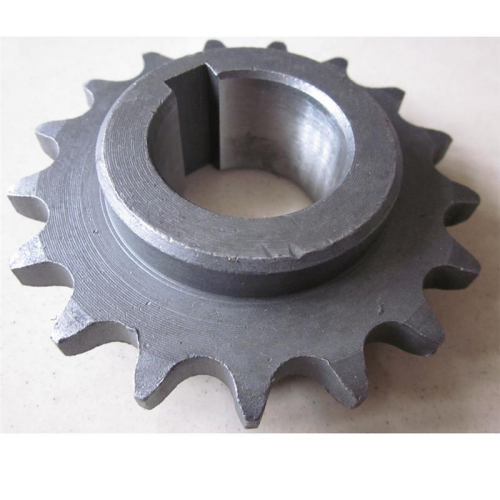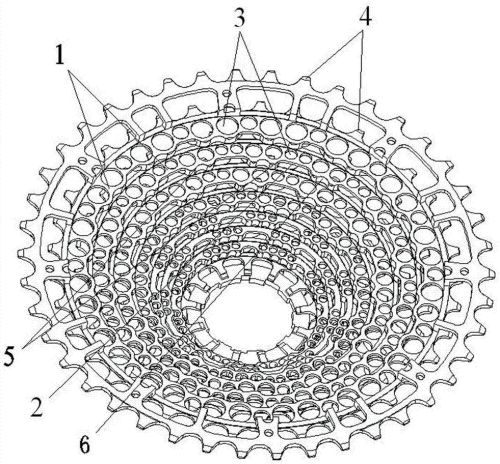The chain wheel is a wheel with embedded teeth of buckling chain to engage with the exact pitch of the block on the chain link or cable. Chain wheel is widely used in chemical, textile machinery, escalators, wood processing, three-dimensional parking garage, agricultural machinery, food processing, instrumentation, petroleum and other industries of mechanical transmission, etc.

Chain wheel end face tooth shape
Chain wheel tooth shape must ensure that the chain energy can enter and exit the engagement smoothly and freely, minimize the impact and contact stress of the chain links during the engagement, and be easy to process. It is composed of three arcs aa, ab, cd and a straight line bc, referred to as three arcs - straight line tooth shape. The tooth shape is processed with standard tools, and it is not necessary to draw the end face tooth shape on the working diagram of the sprocket wheel, but it is only necessary to indicate on the diagram that "the tooth shape is manufactured according to 3RGB1244-85", but the shaft face tooth shape of the sprocket wheel should be drawn, and its size should be referred to the relevant design manual.

Sprocket Structure
Figure 2 shows the structure of four kinds of commonly used sprockets. Small diameter sprockets are generally made into integral type (Figure 2a), medium diameter sprockets are mostly made into spoke plate type, and holes are made in the spoke plate for easy handling, card loading and weight reduction (Figure 2b), and large diameter sprockets can be made into combined type (Figure 2d), at which time the tooth ring and core can be made of different materials. For example, C45, stainless steel and other materials.
The causes of severe wear of the chain nest of the sprocket wheel are as follows:
(1) Adhesive wear The greater the load, the higher the surface temperature, and the more serious the adhesion phenomenon. For a certain hardness of the metal material, the wear test under different pressure to get the wear rate and pressure relationship graph, when the pressure reaches more than 1/3 of the material hardness, serious wear will occur. According to the stress distribution diagram, it is known that the maximum stress contact point is at the maximum pressure, and its value is 884.4 MPa. because the quenching hardness at the chain nest is HRC48~52, and its corresponding hardness value is 4800 MPa. therefore, the pressure is much less than 1/3 of the material hardness, so the adhesive wear is not the main form of sprocket wear.
(2) Contact fatigue wear
The sprocket wheel and chain friction sub is alternating contact stress, and fatigue pitting is easily formed on its friction surface. The index to judge the metal contact fatigue strength is the contact fatigue limit, that is, the maximum stress without pitting under a certain number of stress cycles. 40Cr by surface quenching treatment of its contact fatigue limit σ0H = HRC17 +200, calculated σ0H = 1016 MPa. according to the stress distribution diagram can be seen that the maximum stress value of sprocket chain nest is 884.4 MPa. its value is very close to the sprocket surface The value is very close to the allowed contact fatigue limit of the sprocket surface, and at the maximum stress, it is easy to cause pitting failure. However, due to the poor lubrication conditions of the sprocket and chain, pitting is not formed in time and wear is already caused, and the main form of damage at this time is wear instead of pitting. Contact fatigue wear is the main form of sprocket wear, and it basically determines the sprocket service life.
(3) Abrasive wear
Because the chain inevitably comes into contact with coal dust, a little coal dust sticks to it and is brought into contact with the chain nest of the sprocket wheel. The coal dust contains a little sharp and hard sand, which will cause the surface material of the sprocket wheel to fall off in the process of friction, and this is the abrasive wear. Abrasive wear is related to the hardness of the friction material and the hardness of the abrasive. From the graph of the influence of abrasive hardness on wear, it can be seen that when the hardness of abrasive is close to the hardness of the friction material, it causes the friction material to wear at high speed, because the coal powder is mixed with a little sharp and hard sand, which is one of the main reasons to accelerate the wear of the sprocket.
Improvement measures
The service life of the chain wheel is short and far from meeting the requirements of production practice. According to the use condition, processing status and manufacturing technology of the chain wheel, some improvement measures are proposed for the chain wheel:
(1) The design material of the original chain wheel is 40Cr, the overall quenching hardness is HB220~250, and the teeth quenching HRC48~52. This method can not improve the wear resistance of the chain wheel basically on this basis because of the limited quenching hardness of the teeth. It is recommended to change the sprocket material to 20CrMnTi, carburizing and quenching treatment, the hardness of the chain nest can reach more than HRC60, and its wear resistance is more than 2.5 times of 40Cr material. This can greatly improve the service life of the chain wheel, reduce the frequency of repairing the machine, improve productivity and reduce production costs;
(2) The shape of the original sprocket chain nest is forged directly, which has large dimensional error and rough surface, and also reduces the wear resistance. With the wide application of CNC machine tools and the reduction of processing cost, it is recommended to leave a small margin after forging and finish machining by digital milling to improve the dimensional accuracy and surface roughness so as to achieve the purpose of improving wear resistance.
Maintenance
1. The elasticity of the sprocket should be suitable, too tight will increase the power consumption and the bearing is easy to wear; too loose the sprocket is easy to jump and take off the chain. The tightness of the sprocket is about 2%-3% of the center distance of the two sprockets when it is lifted or pressed from the middle of the sprocket.
2. The sprocket should be installed on the shaft without swinging and skewing. The end surfaces of two sprockets in the same transmission assembly should be located in the same plane. When the sprocket center distance is below 0.5m, it can deviate by 1mm; when the sprocket center distance is above 0.5m, it can deviate by 2mm. However, there should not be the phenomenon of rubbing the side of the sprocket teeth, if the two wheels are offset too much, it is easy to produce off-chain and accelerate the wear. When replacing the sprocket, attention must be paid to checking and adjusting the offset.
3. After the sprocket is worn seriously, it should be replaced with new sprocket and new chain wheel at the same time to ensure good engagement. It is not possible to replace only the new sprocket or new sprocket alone. Otherwise, it will cause bad meshing to accelerate the wear of new sprocket or new sprocket. The chain wheel tooth surface should be turned over in time after it is worn to a certain degree (referring to the sprocket with adjustable surface) to extend the use time.
4. If the new sprocket is too long or elongated after use, it is difficult to adjust, the chain link can be removed depending on the situation, but it must be an even number. The chain link should be passed through the back of the sprocket, the locking piece should be inserted outside, and the opening of the locking piece should face the opposite direction of rotation.
5. The sprocket should be filled with lubricant in time during work. The lubricant must enter the mating gap of the roller and inner sleeve to improve the working condition and reduce the wear.
6. The old sprocket should not be mixed with part of the new sprocket, otherwise it will easily produce impact in the transmission and pull off the sprocket.
7. When the machine is stored for a long time, the sprocket should be removed and cleaned with kerosene or diesel oil, and then coated with oil or grease and stored in a dry place.
Usage
As a new gear product, the transmission speed of the sprocket is high, and in its specific application process because it has the advantage of high speed leads to the generation of very little noise, which is also conducive to the realization of a good processing environment shaping. In its application, the sprocket wheel is not only installed with high precision, but also the processing precision is very ideal, which can save a lot of trouble for the future maintenance work. And the advantages of the compact structure of the sprocket wheel make it have a large transmission ratio, and its own service life is also relatively high.
GIDI CHAIN LIMITED supply lots of roller chain, conveyor chain, Leaf Chain, welded chain, forged chain, Palm Oil Mill Chain, Hoisting Chain,Mine and Metallurgy Chain, etc. totaling over 3000 varieties. and 90% of chains are exported to worldwide, Which mainly export to Southeast Asia, European, North America, South America. Chains are welcomed by customers with the excellent quality. Our company owns more than 100 sets of advanced and professional manufacturing equipment, Perfect and rigorous QC system is implemented in every process from material purchasing to finished products packaging. Also, we have passed the ISO9001: 2015 Quality Management System Certification.
More Detail : www.gidi-chain.com
